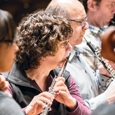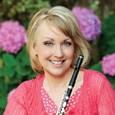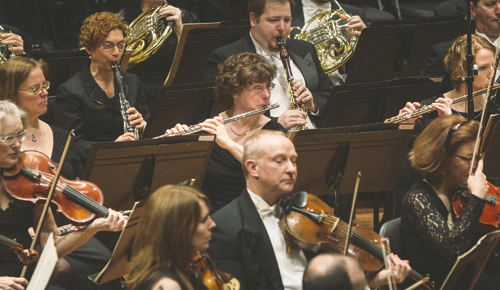
Zart Dombourian-Eby, piccolo of the Seattle Symphony, is a regularly featured performer with the orchestra as a piccolo and flute soloist. She was the founding editor of Flute Talk magazine and is currently serving as president of the National Flute Association. She has also held positions in the Baton Rouge Symphony, New Orleans Pops Orchestra, Colorado Philharmonic Orchestra (now known as NRO), the Civic Orchestra of Chicago, and substituted in the Chicago Symphony Orchestra. She is a graduate of Louisiana State University (BA cum laude, MM) and Northwestern University (DMA). Her doctoral paper, “The Piccolo in the Nineteenth Century,” represents the only extensive research undertaken on the piccolo in that era.
What were your first experiences as a professional musician?
My father was one of the conductors of the New Orleans Summer Pops, a professional orchestra in New Orleans. I played second flute in that orchestra for several summers while I was in college at Louisiana State University. Also while at LSU, I played in the Baton Rouge Symphony.
How did you come to audition for the Seattle Symphony?
There were actually two auditions for my position. The first, in November of 1981, ended with the orchestra not awarding the position to anyone, and I didn’t even progress past the preliminaries. They held the next audition the following March. Braniff Airlines was about to go out of business and offered a two-for-one special on airfares. My friend Amy Hamilton and I decided to go again, since we could get a good deal on the flight. There were about 75 people in the preliminaries and 17 in the finals. I lucked out (played my best Classical Symphony ever) and won the job. My advice to others facing auditions is to really know the excerpts backwards and forwards, but also be ready to showcase your musical personality and expression.
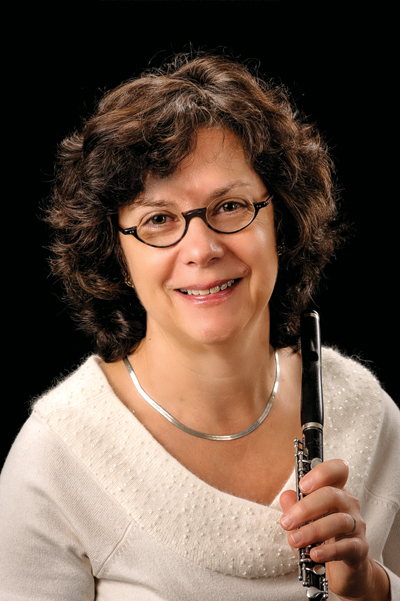
What is your weekly symphony schedule?
My schedule, like that of many orchestra players, varies greatly from week to week. A basic week consists of four to five rehearsals and three to four concerts, but each week is different. Monday is my day off, which I devote to the gym, the National Flute Association, and my high school students.
How do you view the piccolo’s role in the orchestra?
The piccolo is the icing on the cake of the orchestra. The piccolo adds color and excitement and even beauty to the fabric of the music. There are lots of birds and whistles, but we also get to impart soulful melodies such as those found in works of Shostakovich.
How do you manage the demands of family life and an orchestral career?
My two daughters are now grown. In fact, we are looking at wedding venues for one of them right now. My kids were always surrounded by music. When my older daughter was five years old, she was able to sing the flute solo from Daphnis and Chloe as she had heard it so frequently. I did not teach as much when the girls were younger, and I have always been involved in supporting their school activities. I have a long history of participation in the PTA, and I chaired their school orchestra support group, including large fundraisers for three separate trips to Japan. (Both of my daughters are musical, but neither is pursuing a professional career in music.)
Now that my children are older, my free time goes to causes I believe in. I am currently on the Orchestra Committee, hold a position on the Seattle Symphony Board of Directors, and am chair of the Players Pension Plan committee. My involvement with the National Flute Association also has been a major focus over the years.
How did you become involved with the NFA?
The beginning was quite serendipitous. I was visiting a friend in Pittsburgh, and we literally stumbled upon the 1974 NFA convention when we saw Welcome National Flute Association over the front door of a hotel. At the time, I had never heard of the NFA.
Later when I began my studies at Northwestern, I saw that my teacher, Walfrid Kujala, was very committed to the fledgling organization, and I think his passion for it ignited a similar interest in me. Like many other college students, I entered several NFA sponsored competitions and attended conventions.
The convention in 1989 was in New Orleans, my hometown, and I was invited to perform at it. I became a member of the piccolo committee, ran the initial piccolo master class competition, and have subsequently taught and played at many other conventions. I served on the NFA Board twice which is when I really began to understand the scope and complexity of the organization.
That understanding was magnified ten-fold after Jonathan Keeble, flute professor at the University of Illinois and president of the NFA at that time, convinced me to serve as the Program Chair for the convention in Las Vegas in 2012. That was a huge honor, and planning that convention was one of the most exciting projects I have ever undertaken. I learned so much about the flute, flutists, and flute music across the world.
I am currently in the first year of my two-year term as president of the NFA. It is an exciting and demanding position. There are so many details to attend to on an almost daily basis, ranging from financial matters to policy decisions, planning for the 50th anniversary celebration to refining competition guidelines. All the work is worth it, however, as this organization is such a source of camaraderie, knowledge, and excellence.
My biggest objective during these two years is to increase the benefits offered to members and to reach new members. I want everyone to know that the NFA welcomes all flutists, from beginner to professional, from teacher to amateur, and that we have so much to offer flutists at every level. The NFA’s mission is “Inspiring Flutists, Enriching Lives,” and our vision is to be “known as a premier resource worldwide, valued by its members and relevant to all interested in the flute.” These are the guiding principles that drive everything that we do.
What is your practice routine?
I start every day by playing long tones, and then a series of intervals. I move on to Moyse De la Sonorite, No. 3, and then play through all the major and minor scales. I finish off my warm up with some of Trevor Wye’s tonguing exercises.
There are so many moments in all genres of the repertoire where the passion and beauty of the music are so overpowering that you forget your surroundings, your worries, everything around you – those are the moments we live for as musicians. That is what motivates me and keeps me practicing.
Do you use alternate fingerings?
All the time! I agree with Jan Gippo’s philosophy of calling some of the alternative fingerings we use on the flute as primary fingerings for the piccolo. I introduce these fingerings to my piccolo students when they occur in the literature. Hopefully the fingerings will feel natural to students because they have learned to use them in context. It is almost like learning a second language where instead of translating a word in your head, you begin to think directly in the new language. This is how it should work with fingerings. Students should naturally begin to use the new fingerings in an automatic way. I learned a lot about alternative fingering ideas from Wally Kujala through his Vade Mecum, which echoes the ideas of Henri Altès. For example, it makes a lot of sense to keep some of the right hand fingers down for C# in the staff when moving to or from D.
What was it like as the first editor of Flute Talk?
The first issue was released in September of 1981. The magazine was only eight pages long, in one color and with matte paper. It was geared for students and to keep it fun we included a cartoon and a word search puzzle. There was also an interview of James Galway, and Wally Kujala wrote an article called An Homage to Altès. There was a performance guide for a movement of the Handel Sonata in F Major. I still remember some telephone interviews I did for the magazine in the ensuing months. Early interview subjects like Ransom Wilson and Jeff Zook are still lifelong friends to this day. After I moved to Seattle, I kept up my editorial duties by snail mail for a few months (no email in those days) and worked with Polly McKay as she transitioned into the editor position, taking over in October of 1982.
How much do you teach?
Playing in the Seattle Symphony is my primary job, but I teach quite a bit and have since I was a graduate student. I usually have three weekly high school students, and between 10 to 15 semi-regular students, who range from flutists between their bachelor’s and master’s degrees to adult amateurs returning to the flute during retirement after a long hiatus from playing. I find the teaching stimulating, as well as helpful to my own playing.
My primary focus is on tone quality with all my students. Without a good sound, whether it is on the flute or the piccolo, no one will want to listen to you, even if you have the world’s greatest technique or are the most musical player. Sound must come first. I encourage all my students to read Music and the Flute by Tom Nyfenger. It is a book that immeasurably changed both my playing and teaching.
What led to your edition of Vivaldi piccolo concertos?
I periodically teach a summer piccolo and flute masterclass in Seattle, and always ask the performers to prepare at least one movement of a Vivaldi concerto for the class. After several summers using an overhead projector to display my preferred articulations and dynamics for the class, my colleague and friend Sandy Saathoff suggested I put out my own edition of these works. It seemed like an excellent idea, so I got to work on it. I soon discovered, much to my surprise, that there was actually a facsimile edition of the three piccolo concertos available for purchase, so I was able to produce my edition based directly on the original writing of Vivaldi. I decided to make a real performance edition, complete with not only articulations and dynamics, but also suggested ornamentation and special fingerings. The publication is unusual in that it includes all three concertos in one edition. It was a fun project, and I am really proud of how it turned out. (Three Concertos for Piccolo Composed by Antonio Vivaldi/Dombourian-Eby is published by Theodore Presser Co.)
Have you commissioned new repertoire for the piccolo?
My first foray into this was spearheading 150 students to commission Gunther Schuller to write a concerto honoring our teacher’s (Walfrid Kujala’s) birthday. Kujala and the Chicago Symphony premiered the work during the 1988 season. Since then, I have commissioned two works from Martin Amlin (Sonata for Piccolo and Sonatina Piccola), one from Ken Benshoof (In Shadow, light for piccolo and strings, which I also recorded), and sonatas for piccolo and piano by Gary Schocker and Levente Gyongyosi. Each work is very different from the other, and I love them all. I am very proud to have added to the piccolo repertoire in this way.
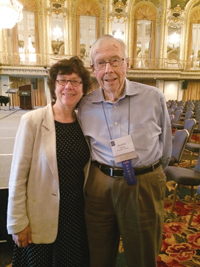 Do you have a role model?
Do you have a role model?
Wally Kujala has been my role model since my first days as a DMA student at Northwestern. His professionalism and love of music and the flute inspired and compelled me to pursue a career in orchestral playing. His teaching methods and focus have molded my own approach to teaching and my students. And his commitment to scholarship and service has guided my pursuits and my
work for the National Flute Association.
* * *
Early Music Studies
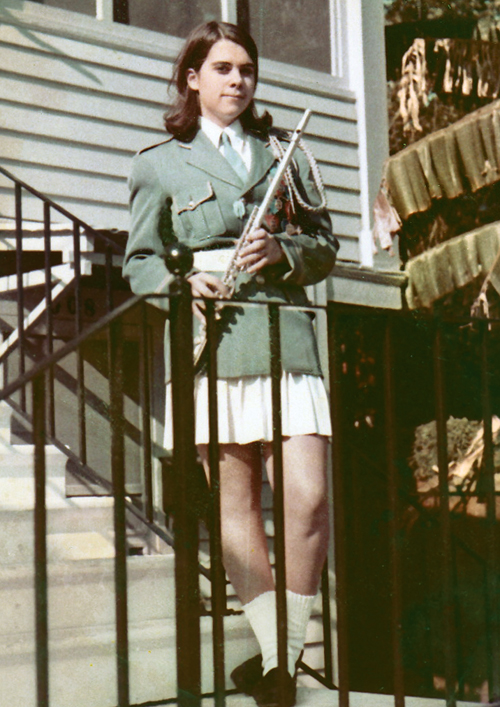 I played the flute because my father, who was a renowned high school band director and orchestra conductor in New Orleans, said that I was going to play the flute. My older sister played flute as well – and my dad, even though he was primarily a violist, played flute as his second instrument. My maternal grandmother was a piano teacher. I started the flute when I was in the fourth grade at my elementary school in New Orleans, and started violin at the same time. I played the violin for six years, then the cello for six years after that, but the flute finally won, and I stuck with it. I studied with both Jeanne and Everett Timm at Louisiana State University.
I played the flute because my father, who was a renowned high school band director and orchestra conductor in New Orleans, said that I was going to play the flute. My older sister played flute as well – and my dad, even though he was primarily a violist, played flute as his second instrument. My maternal grandmother was a piano teacher. I started the flute when I was in the fourth grade at my elementary school in New Orleans, and started violin at the same time. I played the violin for six years, then the cello for six years after that, but the flute finally won, and I stuck with it. I studied with both Jeanne and Everett Timm at Louisiana State University.
I started playing piccolo at the end of sixth grade – the eighth-grader who played piccolo was moving on to high school, so the band director handed me a piccolo right before summer vacation, along with a copy of the Vivaldi C Major piccolo concerto, and said “Learn this.”
I played piccolo occasionally throughout school and college and always enjoyed it, but never considered myself a specialist on it. Because a lot of my playing was in school bands, it just made me happy to be able to hear myself. I have always enjoyed playing piccolo and kind of fell into becoming a piccolo specialist. Even though Walfrid Kujala was my primary mentor, we did not work on the piccolo all that much. When I was preparing for auditions, he would coach me on the excerpts, but I don’t recall ever having a special piccolo lesson with Wally or anyone else.
I worked with Albert Tipton for a short time in Houston, and he stressed intonation. He had a series of exercises using difference tones that we would improvise on. Kujala focused on the precision of orchestral excerpts: getting to the essence of each different one through articulation, rhythm and technique. Of course, we also worked both flute solo repertoire and Vivaldi concertos. I also worked frequently with Donald Peck through the Chicago Civic Orchestra in weekly sectionals. His approach complemented Wally’s perfectly, and he seemed to highlight expression and sound in a slightly different way.
* * *
A Visit to China
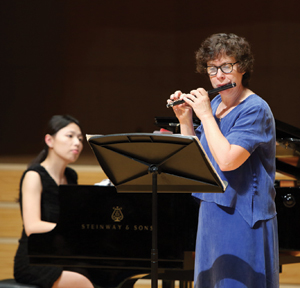 I taught at the University of Washington for a while when Felix Skowronek was ill. One of the graduate students I taught, Zhao Chen, went home to China after graduation and became the flute professor at the China Conservatory in Bejing. One of my daughters was working in China at the time, so when I visited with her, I would keep in touch with my former student and give masterclasses at his school , as well as teach private lessons to his students. Several of his students have become friends of mine, and I see them every time I visit China, or when they visit the US.
I taught at the University of Washington for a while when Felix Skowronek was ill. One of the graduate students I taught, Zhao Chen, went home to China after graduation and became the flute professor at the China Conservatory in Bejing. One of my daughters was working in China at the time, so when I visited with her, I would keep in touch with my former student and give masterclasses at his school , as well as teach private lessons to his students. Several of his students have become friends of mine, and I see them every time I visit China, or when they visit the US.
The first of the biennial China flute conventions was held in 2012, and in 2014 I received an invitation to perform and teach at their second one. The conventions are run by the energetic and creative, Guoliang Han, principal flutist of the China National Symphony, and professor of flute. All of the major Chinese flutists were there, as well as international artists from nine different countries.
While at the convention, I taught a masterclass, judged the young artist competition, and performed a recital. I have been told that it was the first piccolo recital ever presented in China. While that may seem surprising, even in the US a piccolo recital was rare 20 years ago. The recent expansion of piccolo solo repertory has been huge and allows us a rich depth with choices far beyond the Vivaldi concerti.
